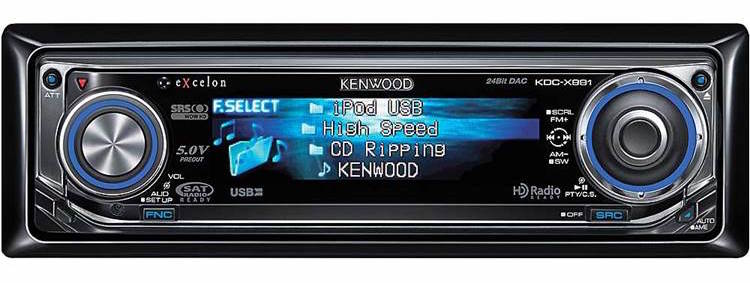When I was 17 years old I started working in this business and it was at that time I was introduced to the Kenwood eXcelon line. It always bothered me that the X was capitilized. To this day, I don’t know why that is. What I do know, is I’ve always been partial to the Kenwood eXcelon line up because of its strong focus on sound quality. My KDC-X890 and subsequent KDC-X991 were incredibly difficult for most of our clients to use. While navigating the maze of menu’s, inevitably you would tap the multi-directional knob the wrong way and have to start all over again. But it sure sounded great.
I would spend hours in my car setting up all of my settings like digital time alignment, the multi-band EQ and testing the various audio effects like “TruBass” or “Focus”. Not only did my Kenwood eXcelon stereo sound great, it looked pretty sharp. I can recall one of the earlier models I owned featuring awesome graphics such as dancing dolphins on the display. It would even wish me a happy birthday. Or maybe that was an older Alpine model? Either way, I have very fond memories of these older single din units. To someone just getting into the car stereo scene, eXcelon was the stuff of legends.
Oddly enough, I think my original attraction to Kenwood had to do with their single din radio esthetics. The blue and red illumination matched my 6-speed VW Jetta GLI dash lights perfectly and it also sounded pretty freaking awesome with my Rockford Punch 360.2. Thus began my love affair with Kenwood eXcelon products.
Historically speaking, Kenwood eXcelon models were reserved for select dealers and select clients that could be viewed as car audio connoisseurs These premium models came with a few added features that you couldn’t get in the mainstream Kenwood line up available at the big box stores. Probably the most popular of features was their gold plated 5 volt pre-amp available exclusively in the Kenwood eXcelon series only. This is still true to this day, although the gold plating is now gone – perhaps due to shrinkflation.
Is there really a difference between the 5 volt and 4 volt pre-amp?
Years ago, I recall an industry rep telling me, very matter of factly, that the pre-amp was the same between Kenwood and Kenwood eXcelon. He told me that they were both 4.5 volts, it was simply all just a marketing ploy. This stuck with me. I had never tested a 5 volt model against a 4 volt model, but I did know my 4 volt Kenwood models on my display board always had more kick than my 4 volt Alpine models so I just always assumed this was probably the case. I had never actually measured it!
Well, I recently invested in a Fluke Scopemeter 123B and have been measuring a lot of stuff lately and decided to find out once and for all. I decided to test the Kenwood DMX7706s against the Kenwood eXcelon DDX9907XR. This would be a battle between a classic Kenwood 4 volt model and a Kenwood eXcelon 5 volt model. I was also curious to find out at what point the pre-amp distorted and at one point the internal amp distorted. I learned a lot.
Testing a Kenwood DMX7706s against a Kenwood eXcelon DDX9907XR using a Fluke 123B Scopemeter
For those unfamiliar with this tool, a Scopemeter – also known as an Oscilloscope – is a tool that is used to test a wide variety of electronic and industrial equipment. It has its uses in a variety of fields such as automotive diagnosis and troubleshooting plus testing and diagnosing all kinds of electronic equipment used in the technology and healthcare industry.
My use for this tool is pretty straightforward. And I’m still learning how to use it so this is like the blind leading the blind here, so bare with me. By attaching the positve and negative probes to the RCA pre-amp output and playing a test tone through each radio – 1 kHz and 40 Hz – we can see at what point the signal begins to distort. We can also measure the voltage. Additionally, we can attach the probes to the speaker wire output of the radio and measure at what point the amplifier in the radio begins to distort.
First up – Kenwood DMX7706s – Is it really 4 Volt?
I connected the Scopemeter to the front pre-amp output of the Kenwood DMX7706s. This is basically a newer version of the Kenwood I have in my own vehicle, a DMX7704s (which I think sounds flipping fantastic). I played the 1kHz test tone through my iPhone connected through the USB and cranked the volume all the way up and this is what I saw.
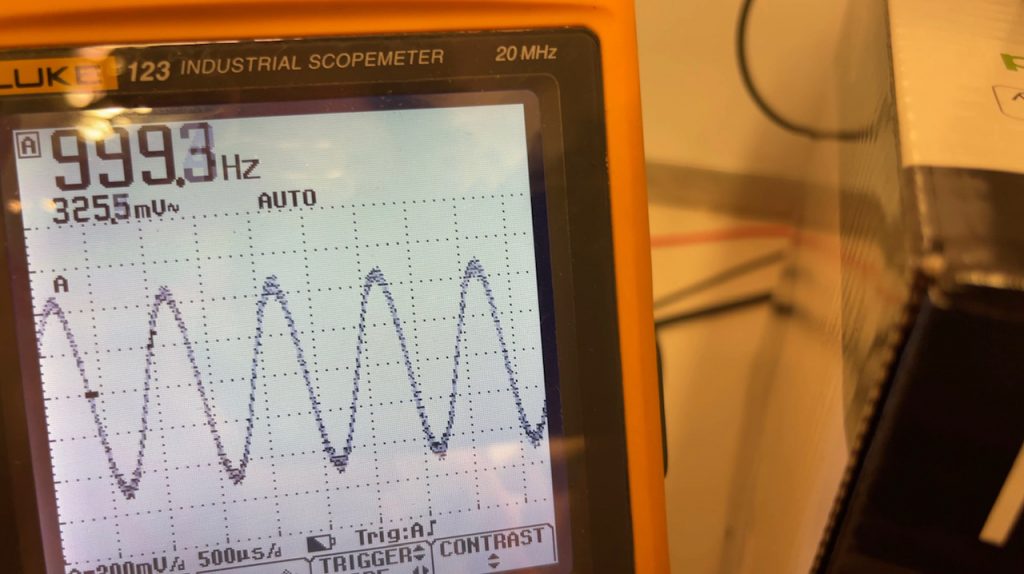
Two things happening here – the signal is clean. But the voltage is only 3.25. Pay no mind the mV~, I still haven’t figured out how to change that part of the display, but what it’s telling us is we’re getting 3.25 volts – I checked it against my Fluke MD-88 to verify. So the bad news is it’s not quite 4 volts on the front pre-amp, but the good news is that signal is clean at max volume on the pre-amp. Next, I decided to check the sub pre-amp voltage with the sub level all the way up.

Additionally I will add that I made sure the EQ was set flat and crossovers were turned off for front, rear and subwoofer. The reason I tested it with the sub level all the way up is it’s pretty much guaranteed this is exactly what my clients will do. I don’t like clients coming back with busted up gear that is a direct result of distortion. For those that aren’t aware, it’s a distorted or clipped signal that will damage your speakers. When you hear the signal breaking up and getting distorted, that’s a bad thing. Distortion is like kryptonite for speakers and subs, avoid it at all costs.
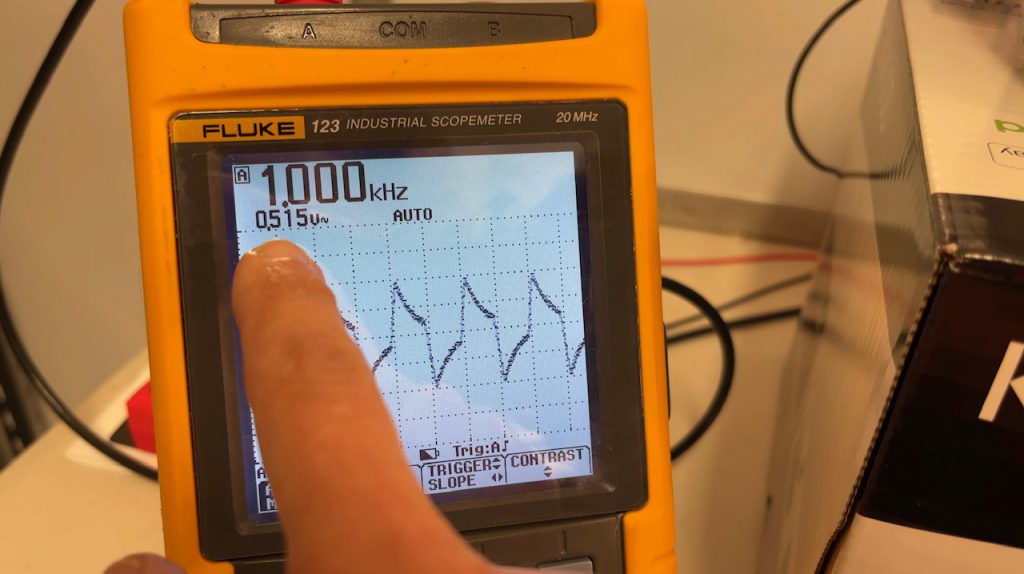
What I found on the sub pre-amp surprised me a bit. With the volume all the way up, the sub level all the way up, and all audio enhancement features turned off like Supreme, Bass Boost, etc., the signal was totally distorted. Yet, we were getting 5.1 volts! But what good was it if the signal was clipping?
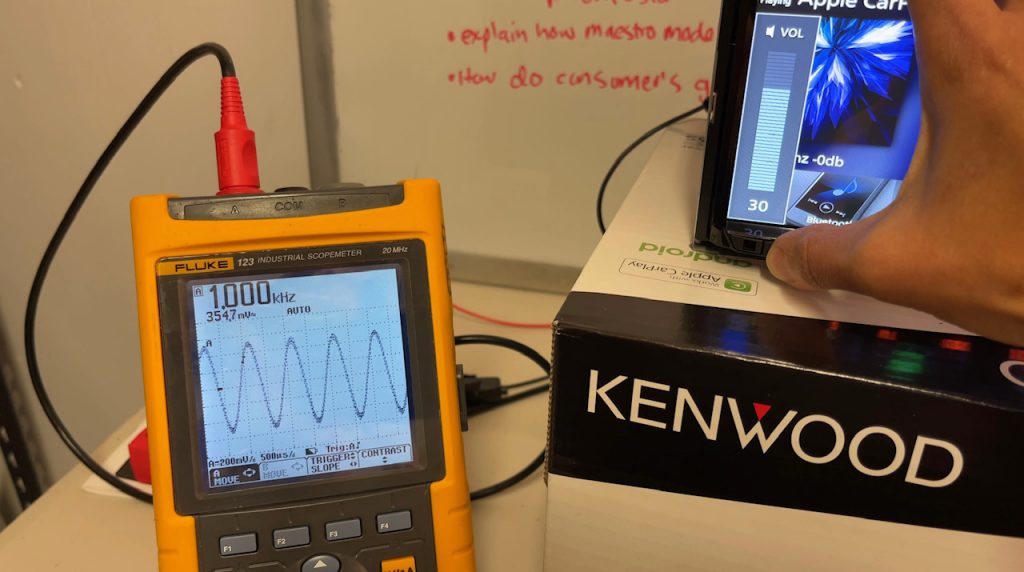
I started to lower the volume to figure out at what point it started to distort. Finally at volume 30, the signal was clean. Bummer! Why would the signal be clean up to 40 on the front pre-amp, but distort at 31 on the sub pre-amp? Also, we were only getting 3.54 volts at that volume level. For comparison, with the Alpine iLX-407, I had to turn the sub level all the way up to get any kind of reading and it was clean even at max volume so I was perplexed. Maybe Kenwood did things differently. I decided to test it again, but this time with the sub level at 0 and with 40 Hz. Here’s what I found.
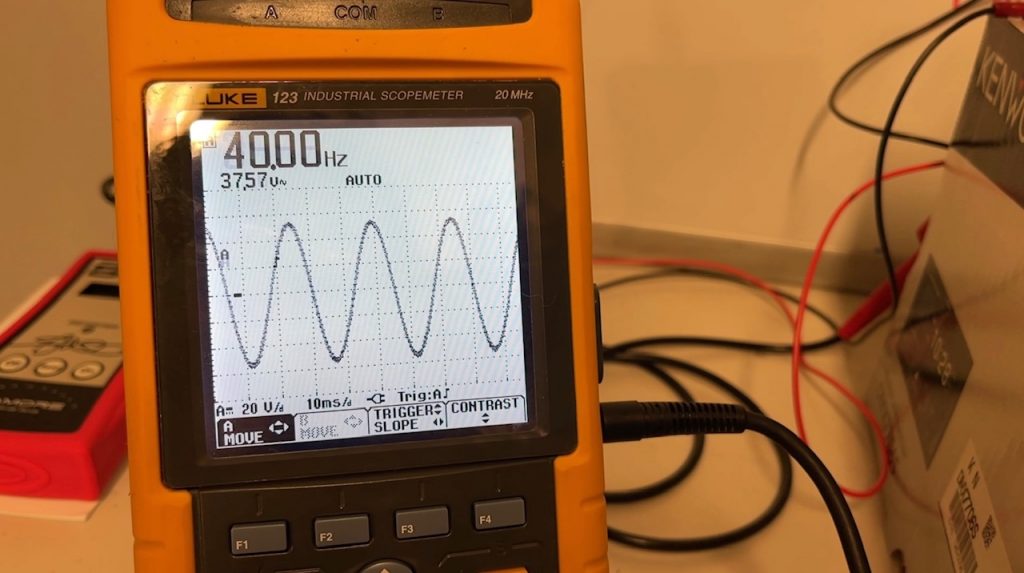
With the sub level at zero, volume all the way up, we got a clean signal. No distortion there and not quite 4 volts, but close to it at 3.75. The below 4 volt reading was definitely a bit of a disappointment, but I did find it interesting that the sub pre-amp definitely has more kick than the front or rear pre-amp. Typically, this is where you really notice the extra voltage, in the bass, so it kind of makes sense that’s where they put the emphasis, but it’s also a bit misleading in the labeling of the product. Consumers see “4 volt” and they assume you mean all three pre-amps are 4 volt not just one out of three. Feeling a bit deflated, I was more anxious than ever to test the Kenwood eXcelon model. Was the DDX9907XR really 5 volt? Or would we see similar results?
Kenwood eXcelon DDX9907XR – Is it really 5 Volt?
I wired up the Kenwood eXcelon DDX9907XR to my test bench power supply and got the Scopemeter probes secured. I opened the test tone on my phone, pressed play and cranked it up. Once again, I started with the front pre-amp and here’s what I found.

Would you look at that? We’re getting 5.29 volts out of the front pre-amp with the volume all the way up and no distortion. Awesome! It really is 5 volts. I guess it’s not just a marketing ploy, there really is a measurable difference. How about on the sub pre-amp? Would we see similar results to the DMX7706s? I switched the probes to the sub pre-amp and turned the sub level all the way up to find out.

Holy cow! We’re getting 8.32 volts out of this thing! But just like the DMX7706s, the signal is totally distorted so it’s not really usable voltage. I lowered the volume to see at what point it would be clean while keeping the sub level at max.
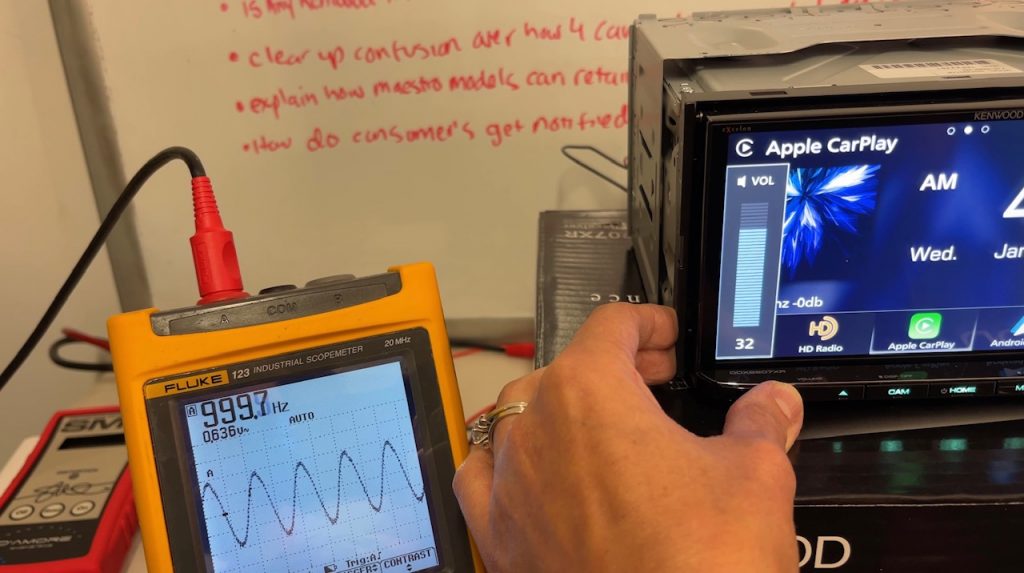
With the Supreme audio setting turned off, the signal started looking clean at 32 and we were getting a whopping 6.36 volts! However, Supreme is a feature I really like using on all Kenwood models because it truly does enhance the sound in every vehicle. I decided to turn on Supreme and found it immediately distorted at volume 32. Stepping it down one notch to 31 cleaned it right up. Plus we were still getting 5.7 volts which is not too shabby.

Now I wanted to see with the sub level at zero, would we still get 5 volts and would the signal be clean at max volume? I adjusted the sub level down, selected the 40 Hz test tone and cranked it up. Here’s what I found.
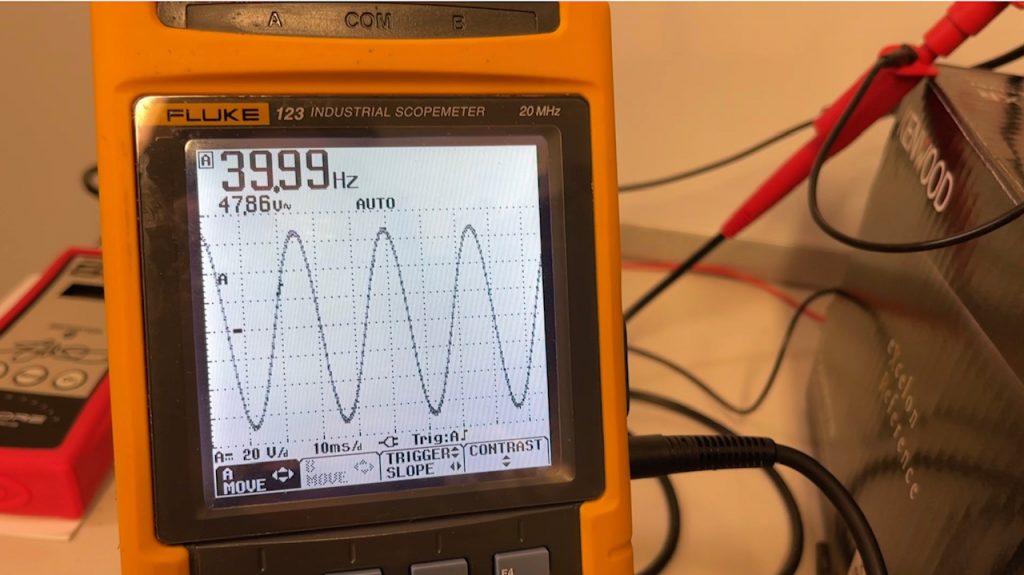
With the sub level turned to zero and volume maxed, we finally had a clean signal through the sub pre-amp. However, it wasn’t quite 5 volts, but close at 4.78.
Kenwood vs Kenwood eXcelon Pre-amp Voltage Distortion Test Results
We can take away some important information from this testing.
- Kenwood’s regular products featuring “4 volt” Pre-amp are not quite 4 volt unless you only count the sub which was 3.78 volts with clean signal. Front pre-amp only measured at 3.25 with fluctuations up to 3.54.
- Kenwood’s eXcelon products definitely have a higher voltage pre-amp – truly 5 volt on the front/rear and almost 5 volt on the sub. This is with the sub level set to zero so the signal stayed clean all the way up to max volume.
- With both head units, the signal stayed clean on the pre-amp at max volume with EQ flat, audio enhancements turned off and sub level set to zero.
- With both head units, we got a ton of voltage out of the sub pre-amp when we turned sub level to the max, but signal started to distort on both around volume 30.
What about their internal amplifiers? When do those start to distort?
A lot of my clients like to build their audio system in phases often starting with the head unit, then maybe adding an amp/sub. For a while they may be powering the stock speakers off the radio with the crossovers turned on before they go ahead and upgrade speakers along with an aftermarket amplifier. Because of that, I wanted to know at what point the amp in each radio started to distort. This allows me to show and tell my clients don’t go past this volume level or you risk damaging your speakers.

With Supreme turned off, I could turn the head unit up to 29 before the signal started to get a bit jagged. Distortion was clearly visible on the scopemeter at volume 30. With Supreme on, 28 was the max I could go and still have clean signal. This was still pretty good when compared against the Alpine iLX-407 which started to distort at 21 out of 35 or 3/5 the volume.
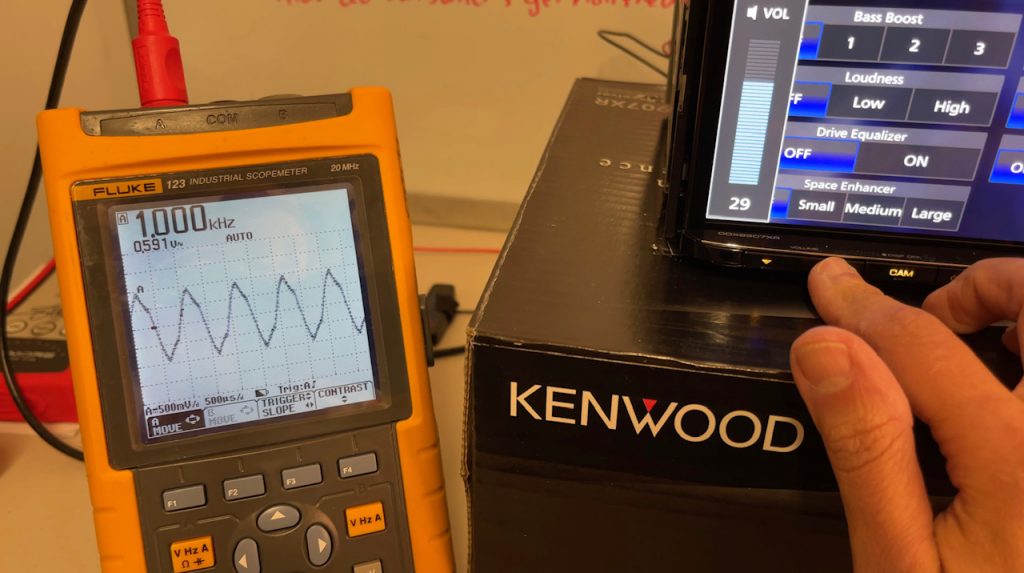
I had the exact same result when testing the Kenwood eXcelon DDX9907XR’s internal amplifier. With Supreme and everything else in the audio menu turned off, the signal remained clean up to volume 29. With Supreme turned on, signal distorted at 29, but was clean at 28.
Kenwood eXcelon – is it worth it?
Clearly the Kenwood eXcelon model had the better performing pre-amp. It was truly higher voltage. In car audio, the higher the voltage on your pre-amp, the more sensitive it’s going to be to your amplifier. This means you don’t have to turn the gains up as high so your amp can work more efficiently and theoretically play cleaner because it’s being less taxed to perform. With a lower voltage pre-amp, you have to turn the gains up higher to get the same audio effect that you’d have when connected to a stereo with a higher voltage pre-amp. For the true audio connoisseurs out there, Kenwood eXcelon is the only choice there is.

